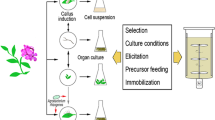Summary
Sphaeroplasts from several genetically marked strains of Trichoderma reesei were readily prepared through enzymatic hydrolysis of mycelial suspensions utilizing Driselase, a commercially available lytic enzyme preparation. Sphaeroplasts were released from the apical tips of hyphae after 90 min exposure to the enzyme and, with longer treatments, from other regions of the hyphae. The efficiency of sphaeroplast formation was dependent upon a number of factors. Young mycelium was far more susceptible to lysis than older hyphae. Additionally, the yields of sphaeroplasts were directly proportional to the mycelial concentration within the range tested (0.7–7.0 mg dry weight of mycelium). Ammonium sulfate (0.6 M) was the most effective osmotic support in relation to sphaeroplast stability during their release from the mycelium and subsequent purification. The most prominent enzymatic activities of Driselase were endo-β-(1→4)-glucanase, β-glucosidase and β-(1→3)-glucanase. No chitinase activity was detected. The combined application of Driselase and chitinase (Streptomyces griseus) to mycelial suspensions resulted in increased sphaeroplast yields from young (18 h) as well as older (24 h) mycelia. The parameters defined here allow the rapid (<6h), inexpensive production of 107 sphaeroplasts/ml. Regeneration of T. reesei sphaeroplasts proceeded by the production of chains of sphaeroplast-like cells followed by true hyphal formation. The frequency of regeneration to mycelial form was dependent upon the length of exposure of mycelium to the lytic enzyme. Less than 1% of the sphaeroplasts prepared from 24 h hydrolytic treatment of mycelia regenerate to form colonies while virtually 100% of the viable sphaeroplasts prepared from 6 h treatment form colonies in regeneration medium.
Similar content being viewed by others
References
Benitez J, Ramos Garcia-Acha S (1975a) Protoplasts from Trichoderma viride: Formation and regeneration. Arch Microbiol 103:199–203
Benitez T, Villa TG, Garcia-Acha S (1975b) Chemical and structural differences in mycelial and regeneration walls of Trichoderma viride. Arch Microbiol 105:277–282
Berger LR, Reynolds DM (1958) The chitinase system of a strain of Streptomyces griseus. Biochim Biophys Acta 29:522–534
Doi Y (1968) Revision of the Hypocreales with cultural observations. I. Hypocrea dichromospora sp. nov, and its Trichoderma state. Bull Natl Sci Mus Tokyo 11:185–189
Finkleman MAJ, Zajic JE, Vardanis A (1980) New method of producing protoplasts of Aureobasidium pullulans. Appl Environ Microbiol 39:923–925
Hamlyn PF, Bradshaw RE, Millan FM, Santiago CM, Wilson JM, Peberdy JF (1981) Efficient protoplast isolation from fungi using commercial enzymes. Enzyme Microbiol Technol 3:321–325
Hoskins JM, Meynell GG, Sanders FK (1956) Exp Cell Res 11:297
Huggett ASG, Nixon DA (1957) Use of glucose oxidase, peroxidase and o-dianisidine in determination of blood and urinary glucose. Lancet 273:368–370
Lowry OH, Rosebrough NJ, Farr AL, Randall RJ (1951) Protein measurements with the Folin-phenol reagent. J Biol Chem 193:265–275
Mandels M (1979) Enzymatic saccharification of waste cellulose. In: The proceedings of the Third Annual Biomass Energy Systems Conference. Golden, Colorado, U. S. Department of Energy, pp 281–290
Mandels M, Andreotti R, Roche C (1976) Measurement of saccharifying cellulase. In: Gaden E et al. (eds) Enzymatic conversion of cellulose materials: Technology and applications. John Wiley and Sons, New York, pp 21–23
Mandels M, Hontz L, Nystrom J (1974) Enzymatic hydrolysis of waste cellulose. Biotechnol Bioeng 16:1471–1493
Mann JW, Jeffries TW, Macmillan JD (1978) Production and ecological significance of yeast cell wall degrading enzyme from Oerskovia. Appl Environ Microbiol 36:594–605
Miller GL (1959) Use of dinitrosalicylic acid reagent for determination of reducing sugar. Anal Chem 31:426–428
Montenecourt BS, Eveleigh DE (1979) Selective screening methods for the isolation of high yielding cellulase mutants of Trichoderma reesei. In: Brown RD Jr, Jurasek L (eds) Hydrolysis of cellulose: Mechanisms of enzymatic and acid catalysis. Adv Chem Ser, pp 289–302
Montenecourt BS, Eveleigh DE (1977) Preparation of mutants of Trichoderma reesei with enhanced cellulase production. Appl Environ Microbiol 34:777–782
Peberdy JF (1980) Protoplast fusion—a tool for genetic manipulation and breeding in industrial microorganisms. Enzyme Microbiol Technol 2:23–29
Peberdy JF (1979) Fungal protoplasts: isolation, reversion and fusion. Annu Rev Microbiol 33:21–29
Peberdy JF, Gibson RK (1971) Regeneration of Aspergillus nidulans protoplasts. J Gen Microbiol 69:325–330
Pontecorvo G (1953) The genetics of Aspergillus nidulans. Adv Genet 5:141–238
Roper JA (1952) Production of heterozygous diploids in filamentous fungi. Experientia 8:14–15
Webster J (1964) Culture studies on Hypocrea and Trichoderma I. Comparison of perfect and imperfect states of H. gelatinosa, H. rufa and Hypocrea sp. Trans Br Mycol Soc 47:75–96
Author information
Authors and Affiliations
Rights and permissions
About this article
Cite this article
Picataggio, S.K., Schamhart, D.H.J., Montenecourt, B.S. et al. Sphaeroplast formation and regeneration in Trichoderma reesei . European J. Appl. Microbiol. Biotechnol. 17, 121–128 (1983). https://doi.org/10.1007/BF00499863
Received:
Issue Date:
DOI: https://doi.org/10.1007/BF00499863




